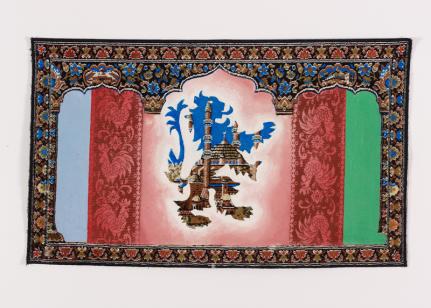
Wim Delvoye
Belgian, 1965-
Creme de la Creme, 1988
Acrylic on carpet
24 3/8 x 40 5/8"
Collection of Connie and Jack Tilton
COMMENTS
Following in the footsteps of Marcel Duchamp and his urinal-turned-sculpture, Wim Delvoye has reinvigorated the age-old debate on what constitutes “art.” Delvoye attempts to democratize art, questioning notions of elitism, as well as forging unexpected links between popular traditions and social issues. The artist is perhaps best known for his provocative installation Cloaca, of which several versions exist since 2000. An elaborate man-made machine that replicates the human digestive system from ingestion through excretion, Cloaca features natural bodily functions that are propelled from the private to the public sphere in a direct challenge to the tacit protocols of the art world. Delvoye’s earlier work from the 1980s and 1990s is largely based on paradox and playfully blending old-world motifs with more accessible, contemporary subjects. In the “Gothic” works, for instance, the Cor-Ten steel bodies of life-size construction equipment (a familiar sight to New Yorkers) are superimposed with a Gothic filigree. Each object’s intrinsic role as a secular, utilitarian icon gives way to the divine associations of a medieval cathedral. The same holds true for Delvoye’s Gas Canisters—commonplace butane gas containers painted in the style of Delft porcelain—and Concrete Mixer (Wedgewood III), which is ornamented with the signature pattern of Wedgewood china and intricately carved in wood. The latter’s combination of functionality and decoration, modern-day technology and traditional craftsmanship is just as the 18th-century ceramicist Josiah Wedgewood would have intended.
- Megan Fontanella, Guggenheim Collections Online, Web, n.d.
SBMA CURATORIAL LABELS
BORN 1965, WERVIK, BELGIUM
LIVES AND WORKS IN GHENT, BELGIUM
Wim Delvoye’s work frequently references his immediate cultural surroundings: the tastes of the petit bourgeoisie and the legacy of Gothic architecture and the Northern Renaissance. Yet these allusions are often expressed in the broader context of global mass production.
Crème de la Crème (1988) belongs to a series of second-hand rugs Delvoye painted with images of heroic figures and animals. A mosque depicted on the original carpet peeks through the painted contours of a heraldic lion, bringing to mind the coat of arms of Flanders—the Dutch-speaking region of Belgium from which Delvoye hails. Painted bands resembling traditional Belgian lace with a rooster pattern recall the coat of arms of Wallonia, Belgium’s French-speaking region.
In the late 1980s, Delvoye began painting industrial objects such as saw blades and gas canisters with iconic blue-and-white Dutch delftware designs. Evoking centuries-old international trade as well as modern-day kitsch, delftware is an ideal referent for the artist, whose work explores issues of authenticity and the value of art and other luxury goods. He also applied this enameling technique on shovels and ironing boards, transforming the utilitarian objects into heraldic shields.
Labour and Wait, 2013
